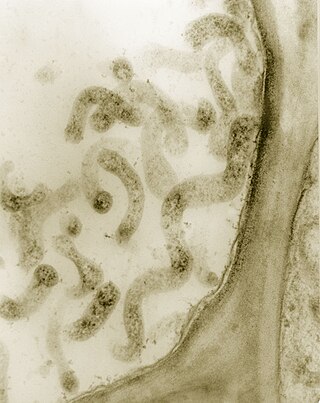The Chloroflexia are a class of bacteria in the phylum Chloroflexota. Chloroflexia are typically filamentous, and can move about through bacterial gliding. It is named after the order Chloroflexales.
The Thermoprotei is a class of the Thermoproteota.
Heliobacteria are a unique subset of prokaryotic bacteria that process light for energy. Distinguishable from other phototrophic bacteria, they utilize a unique photosynthetic pigment, bacteriochlorophyll g and are the only known Gram-positive phototroph. They are a key player in symbiotic nitrogen fixation alongside plants, and use a type I reaction center like green-sulfur bacteria.
The Deferribacteraceae are a family of gram-negative bacteria which make energy by anaerobic respiration.

Entomoplasmatales is a small order of mollicute bacteria.

Acidilobales are an order of archaea in the class Thermoprotei.

The Nitrosopumilales are an order of the Archaea class Nitrososphaeria.
Methanocaldococcus formerly known as Methanococcus is a genus of coccoid methanogen archaea. They are all mesophiles, except the thermophilic M. thermolithotrophicus and the hyperthermophilic M. jannaschii. The latter was discovered at the base of a “white smoker” chimney at 21°N on the East Pacific Rise and it was the first archaean genome to be completely sequenced, revealing many novel and eukaryote-like elements.
The Chloroflexota are a phylum of bacteria containing isolates with a diversity of phenotypes, including members that are aerobic thermophiles, which use oxygen and grow well in high temperatures; anoxygenic phototrophs, which use light for photosynthesis ; and anaerobic halorespirers, which uses halogenated organics as electron acceptors.

The Acidimicrobiia are a class of Actinomycetota, in which three families, eight genera, and nine species have been described, Acidimicrobium ferrooxidans is the type species of the order.
Heliorestis is an alkaliphilic genus of bacteria from the family of Heliobacteriaceae.
Phycisphaeraceae is a family of bacteria.
Haloferacales is an order of halophilic, chemoorganotrophic or heterotrophic archaea within the class Haloarchaea. The type genus of this order is Haloferax.
Halorubraceae is a family of halophilic, chemoorganotrophic or heterotrophic archaea within the order Haloferacales. The type genus of this family is Halorubrum. Its biochemical characteristics are the same as the order Haloferacales.
Haloarculaceae is a family of halophilic and mostly chemoorganotrophic archaea within the order Halobacteriales. The type genus of this family is Haloarcula. Its biochemical characteristics are the same as the order Halobacteriales.
Planctomycetaceae is a family of bacteria.
Gemmataceae is a family of bacteria.
Pirellulales is an order of bacteria.
Lacipirellulaceae is a family of bacteria.
The Pirellulaceae are a family of bacteria.



